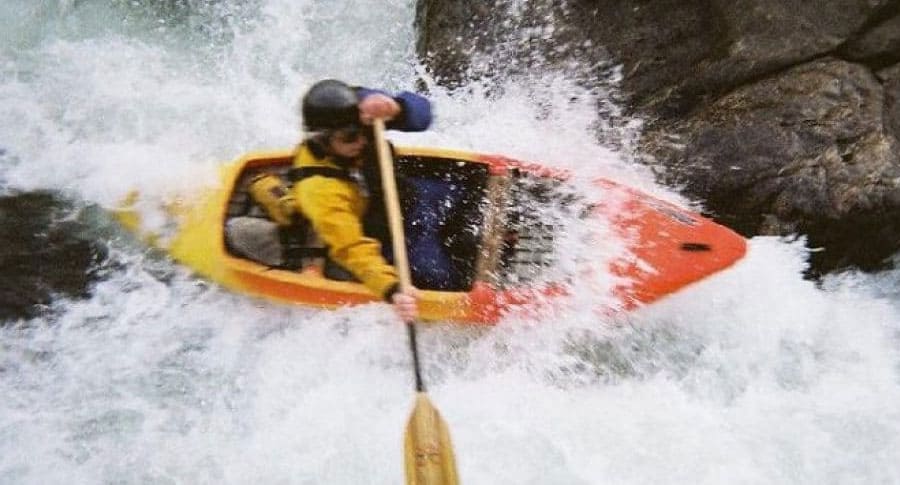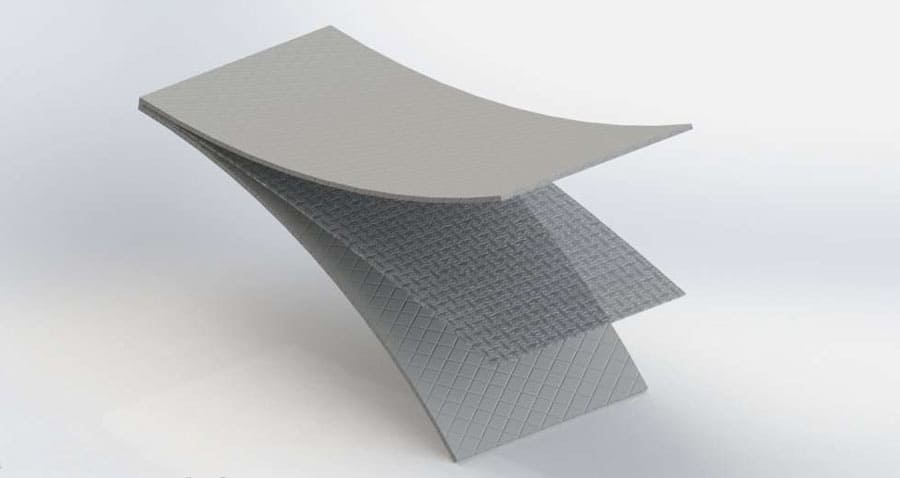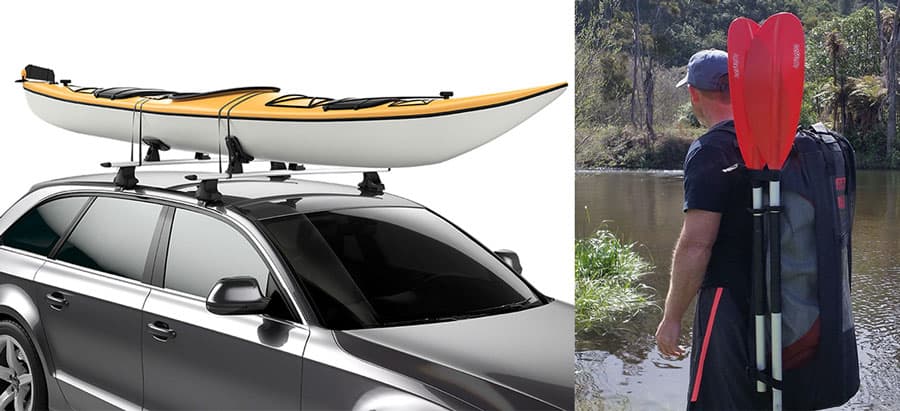Are you unsure whether you should get an inflatable kayak or a hardshell one?
This article lays out the differences between inflatable & rigid kayaks, so you can decide which is right for you.
Let’s start!
Contents
Pros and cons of inflatable vs hard kayaks
If you’re in a hurry, here is a quick table to compare and present the differences between inflatable kayaks and hard kayaks.
| Inflatable kayak | Hardshell kayak | |
|---|---|---|
| Weight and size | Much lighter, a single person can carry it to the water | About 2x as heavy as an inflatable of the same size. You may need 2 people to carry the kayak |
| Transport & storage | When deflated, takes up as much space as a duffle bag. Smaller models are even easier to travel with, great for hiking and camping. | Transported on roof racks or trailers. Ample storage space is required at home in the yard, or garage. |
| Setting up | Takes about 5 minutes to inflate, and 10 to break down. | No setup or break down required, other than the time it takes to strap the kayak onto the roof or trailer. |
| Stability, ease of use | Wider base than hardshells, which provides more stability on the water. Less balance is required to paddle, easier to use for beginners. | Requires more balance, especially on rougher waters. |
| Control | Quality inflatable kayaks offer almost as good tracking and control as hardshell models. | Firmer, sits deeper in the water and provides better tracking, important for whitewater and ocean use. |
| Durability | Quality inflatables are extremely durable. | Extremely durable, but much more expensive. |
| Safety | Good quality inflatable kayaks are just as safe as hardshell ones. | Safe. |
| Costs | Cheaper than comparable hardshell models. | Can be much more expensive, depending on the model. |
The above is meant to be a practical comparison between hard shell and inflatable kayaks. Read on to learn about the details.
Stability – Are inflatable kayaks stable?
Most inflatable kayaks are made with a wider base than hardl kayaks. This means that they are also more stable on the water. It takes real effort to turn them over when someone is sitting in it, which cannot be said of hardshell kayaks.
Beginners generally have a much easier time with paddling an inflatable kayak, as keeping balance is easier. If you a newbie paddler, you will love the stability of inflatable kayaks.
Control and speed
Hard shell kayaks offer better control to advanced paddlers seeking extreme conditions (whitewater, ocean). This is because they sit lower in the water and track better. You need to move much more water with a hardshell kayak to make it go off center and turn it, than you would with an inflatable.

However, inflatable kayaks have improved a lot in the past few years. Good quality models become extremely rigid when fully inflated, and skegs help with tracking (going straight).
Water Safety
Safety should always be your number one priority when out on the water. Whether you are paddling solo or tandem, safety comes first.
- Buoyancy: An inflatable kayak is more buoyant than a hard kayak, because of the multi-chamber approach to manufacturing kayaks. The air in the tubes of an inflatable boat makes it unsinkable, even if it is completely filled with water.
Hardshell kayaks can potentially sink. - Whitewater: You should only attempt riding rough waters in kayaks made especially for the purpose. This holds true for both inflatable and rigid kayaks. The tough construction of inflatable kayaks approved for class 3-4 rapids makes them resistant to pokes and tears from rocks and branches. If an inflatable kayak hits a rock, it simply bounces off.
Hardshell kayaks built for whitewater are also safe.
Even though a fully pumped inflatable kayak is rigid, getting knocked on the head with one in case of an accident is much more forgiving than a hardshell kayak.
If you are worried about the safety of inflatable kayaks, read this article.
Setup time comparison
One of the biggest benefits of inflatable kayaks is that they are easy to store and transport, but this also means that you have to inflate them before use & dry + deflate them afterwards.
How long does it take to set up an inflatable kayak? With a proper air pump, it should not take more than 5 minutes.
Check out these dependable manual and electric air pumps if you don’t have one yet. A bad pump will make inflation difficult and getting the correct air pressure hard.
They really make the setup process easier. The better pumps can even suck out the last trickle of air when deflating, which makes packing the kayak away quicker.
Setting a hard shell kayak up is comparably quicker. You take it off the roof rack, and launch it into the water. Fastening it back on the roof rack will take more time though, as you have make sure it is stable. You may also need a helping hand getting it onto the roof.
Materials used to build kayaks
The material a kayak is made from impacts its price, usage possibilities and maintenance. Here is a quick overview of the materials kayaks are made of, with the pros & cons of each:
Hardshell kayaks are made of the following materials.
- Wood can be used to build kayaks. Wooden kayaks can be built at home using precut kits. Wood and water don’t mix well, so to protect the boat, the wood is covered in fiberglass. This makes wooden boats durable. If you want to have a beautiful kayak that you can build with your own hands, wooden kayak kits are for you.
- Polyethylene (aka plastic) kayaks are the least expensive, but the heaviest of the bunch. They can be molded to form a 1 piece kayak. Repairing them can be a problem, and they are damaged by UV exposure if left untreated.
- Composite kayaks are made of synthetic fabric laminates of fiberglass, graphite fibers and aramid fabric. These kayaks are fast, durable and responsive. They are also expensive.
Inflatable kayaks are made of synthetic fabrics.

- PVC is the most used material. PVC boats are easy to patch, can be heat welded for a solid construction, and are durable. However, PVC is not resistant to UV rays and chemicals.
- Hypalon is a synthetic rubber, which is also commonly used to make inflatables. It is more expensive than PVC, but doesn’t have any of the shortcomings of PVC.
- Nitrilon is the newest type of synthetic rubber, but it is not used as commonly as the materials above. It is very heavy duty, but very expensive.
Durability
You might be concerned about the durability of inflatable kayaks, since, after all, they are made of rubber. This might be true for pool toys, but not so for serious inflatable kayaks.
Good quality models are incredibly durable, you will get many years of use out of them. Here is an article on the lifespan you can expect from one.
I would even go as far as saying that inflatable kayaks are more durable than their hardshell counterparts, with the exception of the fiberglass models.
Here is a video testing the limits of an inflatable kayak.
The life expectancy of an inflatable kayak depends on how well you care for it though. If you leave it out in the sun without protection and pack it away without cleaning, it will only last a few years. Maintenance is important if you want to keep it in good shape.
Weight
As you already know, kayaks can be made from a wide range of materials. This has a direct influence on its weight.
Inflatable kayaks are much lighter than rigid ones. They are made from synthetic rubber and plastic polymers, and typically weigh about 25 pounds (ca. 11 kg).
Hardshell kayaks can be made from composite materials, wood, plastic or fiberglass. They are much heavier, weighing at least 55 pounds (ca. 25 kg). This means that carrying them from the house to the car, then to the water will be more difficult.
Transportation
The advantages inflatable kayaks have over rigid kayaks is evident.

An inflatable kayak is easily deflated and takes up little space, meaning they are very easy to transport.
And even after inflation, the inflatable kayak’s weight will allow a single person to pick it up and take it to the water.
It is a totally different story with hard kayaks. Transporting it is a challenge on its own, since you need to fix it to a roof rack or trailer.
The heavier weight of a hardshell kayak can mean that 2 people are needed to pick it up and take it to the water. Unless you want to drag out on the ground…
Storage
Just like in the transportation category, inflatable kayaks are much easier to store than their hardshell counterparts.
An inflatable kayak can be stored in small spaces, even if you account for the air pump. You can always find somewhere to store them, be it in your car, garage, hotel room, or camping tent. In fact, you can buy inflatable kayaks that fit inside backpack, so you can take them hiking. Just make sure the kayak is dry before storage.
Storing hard shell kayaks can be a real problem, especially if you don’t live in a house with a yard or a large garage.
Capacity
The capacity of both inflatable and rigid kayaks varies from kayak to kayak. The lower limit is around 250 pounds (ca. 113 kg), and the upper limit is around 500 pounds (ca. 227 kg) for both versions.
Generally speaking, the weight capacity of an inflatable kayak will be somewhat higher than that of a comparable hardshell model.
FYI, fishing kayaks have the highest weight capacity.
Maintenance
When comparing hard and inflatable kayaks of similar quality, hardshell kayaks usually need more maintenance than inflatable ones.
Why?
Inflatables are made of flexible, yet durable materials. The strong synthetic materials that inflatable kayaks are made of nowadays are just harder to damage. Even if you manage to puncture it somehow, you can easily fix it with a repair patch.
Hardshell kayaks are more vulnerable to bumps and scrapes. Wooden kayaks require the most maintenance, in contrast to plastic, which is more resilient. But if a plastic does suffer damage, repairs will be rather pricey. Fiberglass is the most durable material used to manufacture rigid kayak. Fiberglass is less likely to require repairs, but it is more expensive to buy upfront.
Cost
An inflatable kayak is lower in price than a comparable hardshell boat, but they are still priced higher than most other inflatable boats. This is because quality inflatable kayaks generally have heavy-duty construction, they are made from the toughest, most durable material. This is why they are resistant to tears and punctures. The good ones at least.
Hardshell kayaks cost are more expensive than inflatable kayaks of similar quality. This is because fiberglass and wood cost more than the composite materials used to manufacture inflatable kayaks.
Hard kayaks are generally more expensive to repair as well. An inflatable kayak can be easily patched if it is punctured. Wood and fiberglass kayak repairs are more difficult.
My Opinion
After reading the above, you should already have an idea of which type of kayak is suitable for you.
Inflatables are incredibly easy to transport and store, since they are light, pack down small and can be taken anywhere. Hardshell kayaks are tougher in this respect, but they are quicker to get out on the water as they require virtually no setup.
- If you are a beginner/intermediate paddler who will boat in calm water and class I-II rapids, an inflatable kayak from this list is the better choice for you.
- The portability of inflatables is a huge factor if you plan on taking your kayak camping or hiking.
- If you’re an experienced paddler going onto rough waters, hardshell models offer better control of the kayak.
- Remember that if you opt for a hardshell model, you need space to store it and a way to transport it.
Regardless, they have one thing in common: both are a lot of fun and very safe if used correctly.





